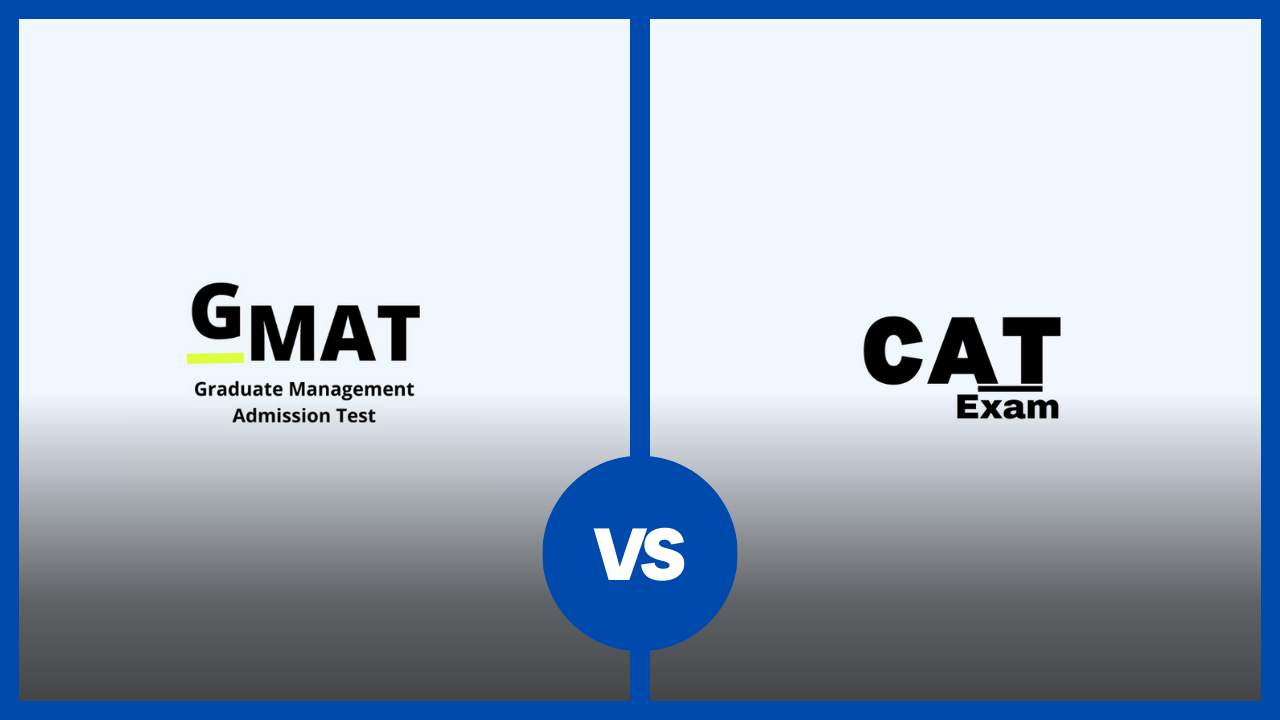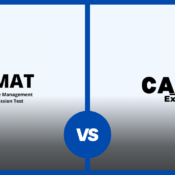
GMAT Vs CAT 2024: Which one is Tough?
Making a decision—between the GMAT and CAT—for Indian students aspiring to pursue an MBA is crucial to their future professional success. Although the structure, content, and operation of these tests are similar they are both MBA entrance exams. However, there are some significant distinctions.
Exam Format and Duration:
The GMAT and CAT share a similar three-section structure, with each exam consisting of Quantitative, Verbal, and Data Interpretation/Reasoning sections. However, the number of questions, time allotted, and section duration vary between the two tests.
- The CAT comprises 66 questions to be answered within 120 minutes, divided into three 40-minute sections.
- In contrast, the GMAT consists of 64 questions spanning 135 minutes, with each section allotted 45 minutes.
While the CAT’s time constraint might seem more demanding at first glance, the GMAT’s adaptive nature adds an extra layer of complexity. Unlike the CAT, the GMAT is an adaptive test, meaning that the difficulty level of each subsequent question depends on your performance on the previous one. This dynamic approach requires consistent focus and accuracy throughout the exam, as a single lapse in concentration can significantly impact the difficulty level of the remaining questions.
Syllabus Coverage and Depth:
Both exams assess fundamental management skills such as quantitative ability, reasoning, and data interpretation. However, the depth and breadth of the syllabus covered by each exam differ significantly.
- The GMAT’s focus addition is well-defined, with a clear outline of the topics covered in each section. This structured approach makes it easier for test-takers to prepare and strategize effectively.
- In the Verbal section, the GMAT places a heavy emphasis on grammar and critical reasoning skills, often posing a greater challenge for non-native English speakers.
- In contrast, the CAT syllabus is relatively broad and ill-defined, necessitating extensive preparation across various topics.
- The CAT’s Verbal section, while still demanding, tends to be more manageable for Indian test-takers due to its focus on comprehension and language proficiency.
- On the Quantitative front, the CAT is generally considered more difficult than the GMAT.
- The CAT’s Quant section covers a broader range of topics, including geometry, trigonometry, and mensuration, which are not part of the GMAT syllabus. This increased breadth of content can make the CAT more time-consuming and demanding.
Preparation Time and Effort:
Both the GMAT and CAT require substantial preparation time and effort, but the nature of the preparation differs due to the inherent differences in the exams.
- For the GMAT, a focused and structured approach is advisable, given the well-defined syllabus and question types.
- With dedicated preparation spanning 90-120 hours, students can achieve a strong percentile score on the GMAT.
- The CAT, however, demands a broader preparation strategy due to its expansive syllabus.
- This often translates into a longer preparation duration, as test-takers need to cover a wider range of topics and practice extensively to build the necessary skills and stamina required for the exam.
Factors to Consider in Choosing GMAT or CAT:
-
Career Goals:
The GMAT is an obvious choice if your career goal is to study abroad and gain valuable international exposure and work experience. It is accepted in over 7,000 programs across 2,300+ graduate business schools worldwide, including highly regarded universities like Stanford, Harvard, and MIT Sloan.
However, as the CAT is recognized by the 20 IIMs and more than 100 other Indian B-schools, it is the recommended option if your main objective is to live and work in India at some of the top business schools.
-
Choice of Program:
Your choice between the GMAT and CAT depends on the specific requirements of the business school and program you’re aiming for. For instance, if you’re eyeing a traditional two-year, full-time MBA program at an IIM, you’ll need a valid CAT score.
On the other hand, if you’re interested in shorter executive programs like EPGP/PGPEx, a target GMAT score is typically required. Moreover, if you’re an international student or applying for international business schools, your GMAT score is often considered for admission.
-
Location Preference:
Your choice between the GMAT and the CAT should take into account the fact that you have chosen to study in a specific area since employers in your intended industry are nearby.
For instance, it would be beneficial to pursue an MBA from a US B-school, for which the GMAT is probably necessary if you’re looking for a position in luxury management with the greatest businesses in the US.
-
Investment vs Return:
When it comes to upfront costs, the GMAT is more expensive than the CAT. The GMAT’s five-year score validity and five test administrations each year, however, lower the test’s annual effective cost.
Additionally, graduates of the top 25 US business schools earn beginning salaries of over $150,000, demonstrating that a strong GMAT score can lead to higher ROI.
-
Scholarships:
Securing partial or full scholarships/fellowships at prestigious business schools is a major benefit of taking the GMAT over the CAT.
A large percentage of new cohorts at international business schools like Harvard Business School are eligible for financial aid, helping offset the rising costs of an MBA.
Read the related article– GMAT vs GRE Which one you should choose for the International MBA
Which One is Tougher?
Depending on a person’s skills, weaknesses, and study habits, the GMAT and CAT can be tough depending on different people. That being said, the CAT is often seen as being more difficult among Indian students. Due to its extensive syllabus, particularly in the Quantitative parts, stringent time limitations, and lack of flexibility, the CAT presents a substantial challenge. In addition, the CAT’s one-year score validity and limited try window increase the test’s pressure and stakes.
Conversely, a lot of students find the GMAT easier to handle because of its flexible schedule, adaptive format, and organized syllabus, which permits up to five attempts each year. When applying to prominent business schools outside of India or studying abroad, GMAT scores are taken into consideration.
If you are Considering GMAT then give a read to: How hard is GMAT?
Conclusion:
It is advisable to obtain help from an experienced MBA Consultant India if you are unclear about which exam to study for or how to approach your preparation. MBA admission consultant will offer you individualized advice based on your objectives, desires, and profile to assist you in selecting between the CAT and the GMAT. Their experience may also come in quite handy when creating a study schedule that works for you and they will also help you in your MBA profile development. Embrace the journey, and let your determination guide you toward your ultimate goal of securing admission to your dream MBA program.



